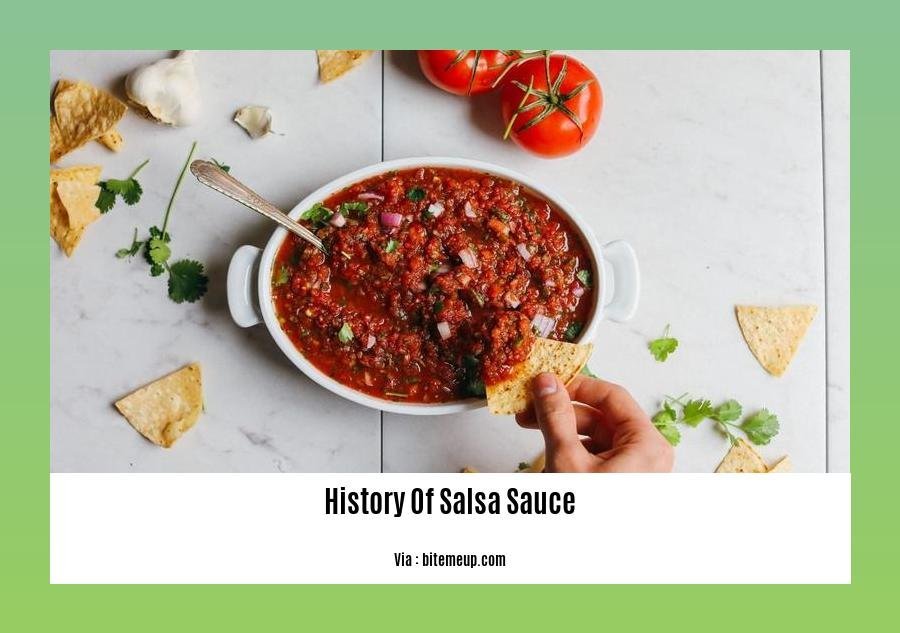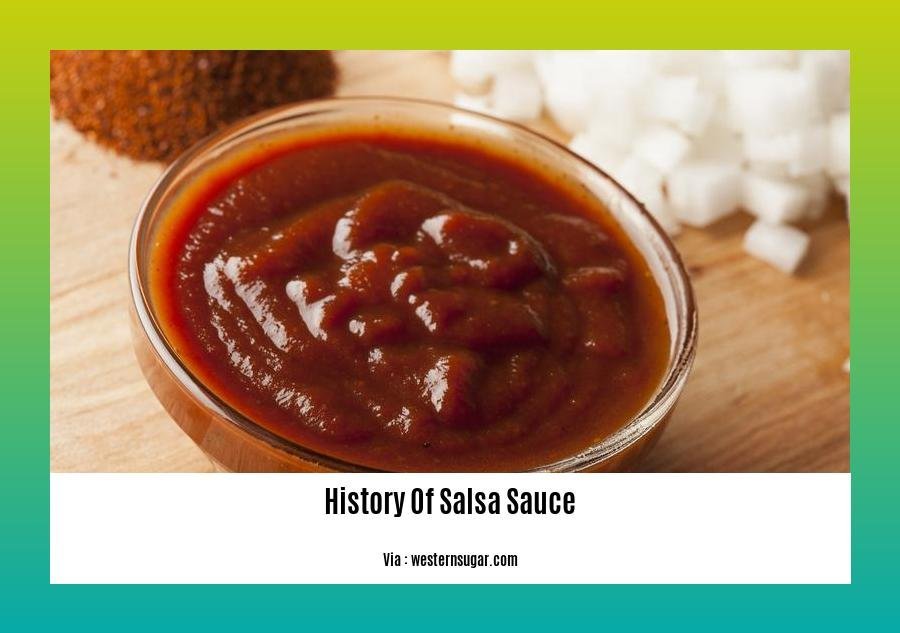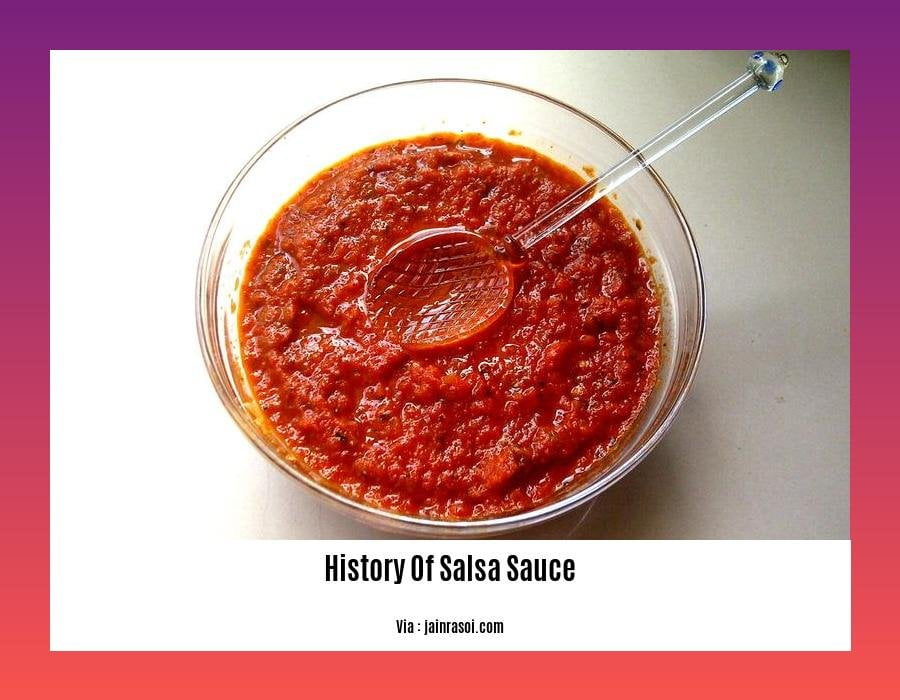Step into a world of flavor as we unveil the captivating history of salsa sauce in our article, “A Spicy Saga: Unveiling the History of Salsa Sauce”. Join us on a culinary journey as we explore the origins, evolution, and cultural impact of this beloved condiment, from its humble beginnings in pre-Columbian civilizations to its global reign today.
Key Takeaways:
- Salsa’s roots can be traced back to pre-Columbian civilizations, such as the Aztecs, Incas, and Mayans, who used tomatoes, chilies, and squash seeds in their versions.
- After the Spanish conquest in 1519-1521, salsa’s history was documented, as the Spanish encountered tomatoes in Mexico.
- Historically, salsa was used as a flavoring sauce or condiment for meat, fish, and turkey.
- The term “salsa” originated from the Spanish word for “sauce.”
History of Salsa Sauce

In the world of condiments, salsa reigns supreme, adding a burst of flavor and zest to our favorite dishes. Its vibrant history is as rich and diverse as the ingredients that comprise it. Let’s embark on a culinary journey to uncover the history of salsa sauce.
The Roots of Salsa
The story of salsa begins in ancient Mesoamerica, where the indigenous civilizations of the Aztecs, Mayans, and Incas crafted their versions of this flavorful condiment using tomatoes, chilies, and squash seeds. These early salsas served as a flavorful accompaniment to their staple dishes, adding depth and complexity to their cuisine.
The Arrival of Salsa in Europe
Salsa’s journey to the global stage began with the arrival of Christopher Columbus in the Americas. The Spanish conquistadors encountered this vibrant condiment and were captivated by its unique flavor profile. They brought salsa back to Spain, introducing it to European cuisine.
The Evolution of Salsa
As salsa made its way across the globe, it underwent various transformations, adapting to different cultures and palates. In Mexico, salsa remained a staple, evolving into a diverse array of regional varieties, each with its unique blend of flavors and ingredients.
In the United States, salsa gained popularity in the 20th century, becoming a ubiquitous condiment in restaurants and homes alike. It found its way onto nachos, tacos, burritos, and countless other dishes, adding a spicy kick to American cuisine.
Salsa Today
Today, salsa is a beloved condiment enjoyed worldwide. It has become an indispensable part of Mexican cuisine, a staple in Tex-Mex restaurants, and a popular ingredient in fusion dishes. From mild to fiery, there’s a salsa for every taste, making it a versatile and flavorful addition to any meal.
So, the next time you savor the tangy zest of salsa, remember its rich history, the culinary journey it has undertaken, and the joy it brings to our taste buds. Salsa is more than just a condiment; it’s a culinary treasure that continues to captivate and delight food enthusiasts around the world.
Ever wondered about the history of quesadillas and how they became a beloved Mexican dish? Delve into the fascinating journey of this culinary delight and discover its origins.
Curious about the history of salsa dip? Embark on a flavor-filled adventure as you uncover the captivating story behind this iconic condiment, from its humble beginnings to its global culinary stardom.
Unravel the history of salsa food and its evolution from a humble condiment to a culinary sensation. Discover the captivating journey of this vibrant sauce, from its ancient origins in Mesoamerica to its modern-day status as a global favorite.
Influence of Mexican Cuisine: The Rise of Salsa in the Culinary World
Salsa, an indispensable condiment in Mexican cuisine, has captivated taste buds worldwide, earning a prominent place in the culinary realm. Its journey began in the kitchens of ancient Mesoamerican civilizations, where the Aztecs and Mayans crafted their unique versions using tomatoes, chilies, and squash seeds. This flavorful creation, initially used to enhance the taste of everyday meals, would embark on an extraordinary odyssey, destined to conquer palates and cultures across the globe.
As Spanish conquistadors traversed the Americas, they encountered this culinary gem and were instantly smitten. Intrigued by its vibrant flavors and versatility, they carried salsa back to Europe, introducing it to a continent eager for new culinary experiences.
In the 20th century, salsa embarked on a new chapter in its culinary saga, gaining immense popularity in the United States. Mexican immigrants, seeking to recreate the flavors of their homeland, brought their beloved salsa recipes across the border. These culinary ambassadors introduced salsa to a nation hungry for authentic Mexican cuisine, transforming it into a ubiquitous condiment in Tex-Mex restaurants and beyond.
Today, salsa stands as a symbol of Mexican cuisine’s profound influence on the global culinary landscape. Its vibrant flavors and versatility have made it a staple in kitchens worldwide, used to enhance everything from tacos and burritos to eggs, grilled meats, and even pizza.
Salsa’s rise to culinary stardom is a testament to the enduring power of flavor and the ability of cuisine to bridge cultures and continents. From its humble origins in ancient Mesoamerica to its current status as a global culinary icon, salsa’s journey is a celebration of the transformative power of food.
Key Takeaways:
- Salsa originated in ancient Mesoamerica, crafted by the Aztecs and Mayans using tomatoes, chilies, and squash seeds.
- Spanish conquistadors brought salsa to Europe, introducing it to new cultures and palates.
- In the 20th century, Mexican immigrants introduced salsa to the United States, where it gained immense popularity and became a ubiquitous condiment.
- Today, salsa is a beloved condiment enjoyed worldwide, used in Mexican cuisine, Tex-Mex dishes, and fusion cooking.
Sources:
Salsa as a Cultural Symbol: Exploring its Significance in Modern Society

In the vibrant world of gastronomy, salsa stands as a culinary icon, a flavor-filled symbol steeped in cultural heritage. Its journey began centuries ago, when indigenous civilizations in ancient Mesoamerica ingeniously crafted a condiment using tomatoes, chilies, and squash seeds. With the arrival of Spanish conquistadors, salsa embarked on a global voyage, captivating palates across continents and evolving into the beloved sauce we know today.
Salsa, in its essence, is more than just a condiment; it’s a cultural ambassador, bridging diverse culinary traditions and uniting people through a shared love for bold flavors. Whether you’re savoring a sizzling fajita, indulging in a zesty bowl of tortilla chips, or exploring the depths of Mexican cuisine, salsa is an indispensable ingredient that elevates the culinary experience.
Over the decades, salsa has transcended borders and permeated various culinary landscapes. In the United States, salsa became an integral part of Tex-Mex cuisine, a vibrant fusion of Mexican and American flavors. It’s a staple in Mexican restaurants, gracing tables alongside tacos, burritos, and enchiladas, adding a burst of flavor to every bite.
Salsa’s versatility extends beyond traditional Mexican cuisine. It has found its way into kitchens worldwide, inspiring culinary innovations and fusion dishes. From salsa-infused marinades and glazes to creative salsas incorporating exotic fruits and herbs, the possibilities are limitless.
As a testament to its global appeal, salsa has become a symbol of cultural exchange and unity. It brings people together, creating shared experiences and fond memories around the dinner table. Its vibrant colors, tantalizing aromas, and diverse flavors reflect the rich tapestry of our interconnected world.
Key Takeaways:
- Salsa originated in ancient Mesoamerica, crafted by indigenous civilizations using tomatoes, chilies, and squash seeds.
- Spanish conquistadors introduced salsa to Europe, where it embarked on a journey of culinary fusion and global recognition.
- Salsa transcended borders, becoming an integral part of Tex-Mex cuisine in the United States, adding a burst of flavor to Mexican dishes.
- Salsa’s versatility extends beyond traditional cuisines, inspiring culinary innovations and fusion dishes worldwide.
- As a cultural symbol, salsa represents unity and shared experiences, bringing people together through its vibrant flavors and rich heritage.
Relevant URL Sources:
Varieties and Regional Diversity: Celebrating the Many Flavors of Salsa
Picture this: a vibrant, flavorful dance across your palate, where tomatoes, chilies, onions, garlic, and cilantro come together in a harmonious blend. That’s the magic of salsa, a culinary delight with a history as rich and diverse as its flavors.
In the culinary realm, salsa reigns supreme as a versatile condiment, seamlessly weaving its way into Mexican cuisine, Tex-Mex dishes, and fusion cooking. But beyond its culinary prowess, salsa is a cultural icon, a symbol of celebration, and a testament to the power of regional diversity.
The salsa family boasts an impressive array of styles, each with its unique character and flavor profile. From the classic Pico de Gallo, with its chunky, vibrant ingredients, to the smooth, velvety Salsa Roja, the smoky, roasted Salsa Verde, and the fiery, habanero-based Salsa Brava, there’s a salsa for every palate.
Salsa’s regional diversity is a testament to Mexico’s rich culinary heritage.
-
Northern Mexico: Salsas from this region often showcase the bold flavors of dried chilies, such as ancho and guajillo, resulting in a smoky, slightly sweet heat.
-
Central Mexico: Salsas from this region are known for their use of fresh, roasted tomatoes, which lend a vibrant red hue and a balanced flavor profile.
-
Southern Mexico: Salsas from this region are characterized by their use of tropical fruits, such as pineapple and mango, which add a touch of sweetness and acidity.
-
Coastal Mexico: Salsas from this region often incorporate seafood, such as shrimp and fish, resulting in a unique, briny flavor.
Key Takeaways:
-
Salsa has a rich and diverse history, originating in ancient Mesoamerica and evolving through cultural exchanges and regional adaptations.
-
Salsa is a versatile condiment used in Mexican cuisine, Tex-Mex dishes, and fusion cooking, adding flavor and depth to a wide range of culinary creations.
-
Salsa’s regional diversity reflects Mexico’s rich culinary heritage, with each region boasting unique styles and flavors that showcase the region’s distinct ingredients and culinary traditions.
-
Salsa has become a global culinary ambassador, enjoyed worldwide for its vibrant flavors and versatility, and is a testament to the power of regional diversity in shaping culinary traditions.
Relevant URL Sources:
-
A Spicy Saga: Unveiling the History of Salsa Sauce
-
Salsa: A Journey Through Flavor and Culture
FAQ
Q1: What are the origins of salsa sauce?
A1: Salsa sauce traces its roots to the Aztec, Inca, and Mayan civilizations, who used tomatoes, chilies, and squash seeds to make their versions of the condiment. The Spanish encountered tomatoes in Mexico after the conquest in 1519-1521, leading to the documented history of salsa sauce.
Q2: What was the initial use of salsa sauce?
A2: Salsa was initially used as a flavoring sauce or condiment for meat, fish, and turkey. It was not until later that it became a popular dip for tortilla chips and other snacks.
Q3: How did salsa sauce gain its name?
A3: The term “salsa” comes from the Spanish word for “sauce.” It was used to describe this condiment due to its liquid consistency and its use as a flavoring agent.
Q4: What are the different styles and flavors of salsa?
A4: Salsa has many different styles and flavors, depending on the region it is from. Some notable styles include Puerto Rican salsa, Colombian salsa, and Cuban-style salsa. Each style has its unique combination of ingredients and preparation methods, resulting in distinct flavors and textures.
Q5: How has salsa sauce evolved over time?
A5: Over the years, salsa sauce has evolved to incorporate influences from various cultures and cuisines. It has also seen the addition of new ingredients and the development of new techniques, leading to a diverse array of salsa varieties.
- Unveiling the Enigma: Mansoureh Khojasteh Bagherzadeh’s Public Appearances & Private Life in Iran - July 18, 2025
- Unveiling the Mystery: Mansoureh Khojasteh Bagherzadeh’s Husband: A Rare Glimpse into a Private Life - July 18, 2025
- Unveiling Masoud Khamenei’s Mother: Power, Influence, and Iran’s Future - July 18, 2025
















